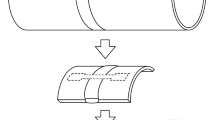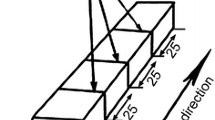Abstract
In the area of heavy construction, welding processes are vital in the production and maintenance of pipelines and power plants. The fusion welding process generates formidable welding residual stress and metallurgical change, which together increase the crack driving force and reduce the resistance against brittle fracturing and environmental fracturing. This is a serious problem with many alloys, and it also arises in A106 Gr B steel pipes. This type of piping, which is used in petrochemical and heavy chemical plants, either degrades due to the corrosive environment, e.g., those containing chlorides and sulfides, and/or become damaged during service due to various corrosion damage mechanisms. Thus, in this study, after numerical and experimental analyses of the welding residual stress of a multi-pass welded A106 Gr B steel pipe weld, the electrochemical corrosion properties and environmentally induced cracking of an A106 Gr B steel pipe weld were assessed in a 5.0 wt.% NaCl solution that was saturated with H2S gas at room temperature on the basis of NACE TM 0177-90. In terms of sulfide stress corrosion cracking (SSCC) and sulfide corrosion fatigue (SCF), the low SSCC limit of smooth specimens, σSSCCsmooth, and the SCF limit, ΔσSCF, were 46 % and 32 % (160 MPa) of the ultimate tensile strength (502 MPa) of an A106 Gr B steel pipe weld, respectively. Further, (Δσres)SCF was assessed under 75 MPa, which is 15 % of the tensile strength.
Similar content being viewed by others
References
C. H. Kim, D. H. Bae, S. Y. Cho, and B. K. Kim, Key Eng. Mat. 183–187, 1345 (2000).
D. H. Bae, S. Y. Cho, C. H. Kim, J. K. Hong, and T. L. Tsai, J. Mech. Sci. Technol. 16, 1054 (2002).
D. H. Bae and C. H. Kim, J. Mech. Sci. Technol. 18, 114 (2004).
H. S. Lee, J. S. Jung, and E. H. Kim, J. Kor. Inst. Met. & Mater. 47, 99 (2009).
J. H. Han, D. N. Nguyen, Y. W. Jang, and J. G. Kim, J. Kor. Inst. Met. & Mater. 47, 558 (2009).
S. W. Kim, S. S. Hwang, and H. P. Kim, J. Kor. Inst. Met. & Mater. 47, 819 (2009).
S. U. Kohm, K. S. Ro, and K. Y. Kim, Corros. Sci. Tech. 1, 130 (2002).
W. S. Chang, B. H. Yoon, and Y. G. Kweon, Corros. Sci. Tech. 3, 81 (2004).
K. K. Baek, H. I. Lee, and C. H. Lee, Corros. Sci. Tech. 3, 154 (2004).
W. Y. Lee, S. U. Koh, and K. Y. Kim, Corros. Sci. Tech. 4, 39 (2005).
V. D. Huy, N. T. P. Thoa, T. Q. Phong, and N. T. Hoang, Corros. Sci. Tech. 4, 95 (2005).
A. J. Sedriks and B. C. Syrett, NACE TM 0177-90 (1990).
G. Y. Lee and D. H. Bae, Proc. Fall Annual Meeting, p. 203, Korean Society of Mechanical Engineers, Yongpyung, Korea (2008).
D. A. John, Principles and Prevention of Corrosion, p. 356–360, Prentice Hall (1992).
Standard Reference Test Method for Making Potentiostatic and Potentio-dynamic Anodic Polarization Measurements, ASTM, G5-94, 03.03 (2002).
Author information
Authors and Affiliations
Corresponding author
Rights and permissions
About this article
Cite this article
Lee, G.y., Bae, D. Assessment of the electrochemical corrosion properties and environmentally induced cracking of an A106 Gr B steel pipe weld in a NaCl solution saturated with H2S gas. Met. Mater. Int. 17, 341–347 (2011). https://doi.org/10.1007/s12540-011-0424-5
Received:
Accepted:
Published:
Issue Date:
DOI: https://doi.org/10.1007/s12540-011-0424-5




